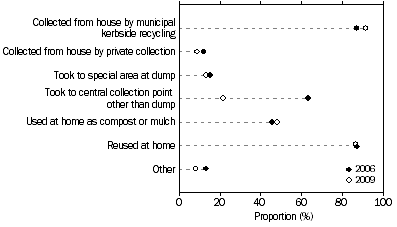WAYS HOUSEHOLDS RECYCLE WASTE
There have been changes to the way households recycle waste. Australians are less likely to have waste collected from the house by private collection, take it to a special area at the dump or waste transfer station, take it to a central collection point other than a dump or waste transfer station, or dispose by other means in 2009 than they were in 2006. This can be partly attributed to the increase in Australian households' use of municipal kerbside recycling, which has increased from 87% in 2006 to 91% in 2009. The Northern Territory has shown the greatest increase in use of municipal kerbside recycling from 60% of households in 2006 to 83% in 2009. Use of municipal kerbside recycling also increased in Western Australia from 77% in 2006 to 89% in 2009. Interestingly, 51% of South Australians have taken waste items to a central collection point other than a dump or waste transfer station, compared to the national average of 22%. This could partly be attributed to items being returned for deposit under the container deposit scheme in operation in South Australia (table 2.5).
WAYS HOUSEHOLDS RECYCLE WASTE - 2006 and 2009

 Print Page
Print Page
 Print All
Print All
 Print Page
Print Page
 Print All
Print All